Intercultural Challenges for Australian Humanitarian Workers in Indonesia
VerifiedAdded on 2023/04/22
|12
|2734
|467
AI Summary
This report discusses the intercultural challenges that Australian Humanitarian workers may face in Indonesia while working on the tsunami relief program. It analyzes the cultural differences between Australia and Indonesia using Hofstede's cultural dimensions and identifies challenges related to cultural hierarchies, direct and indirect communication, and maintaining code of conduct in sacred sites. The report recommends training the workers on cultural competencies to overcome these challenges.
Contribute Materials
Your contribution can guide someone’s learning journey. Share your
documents today.
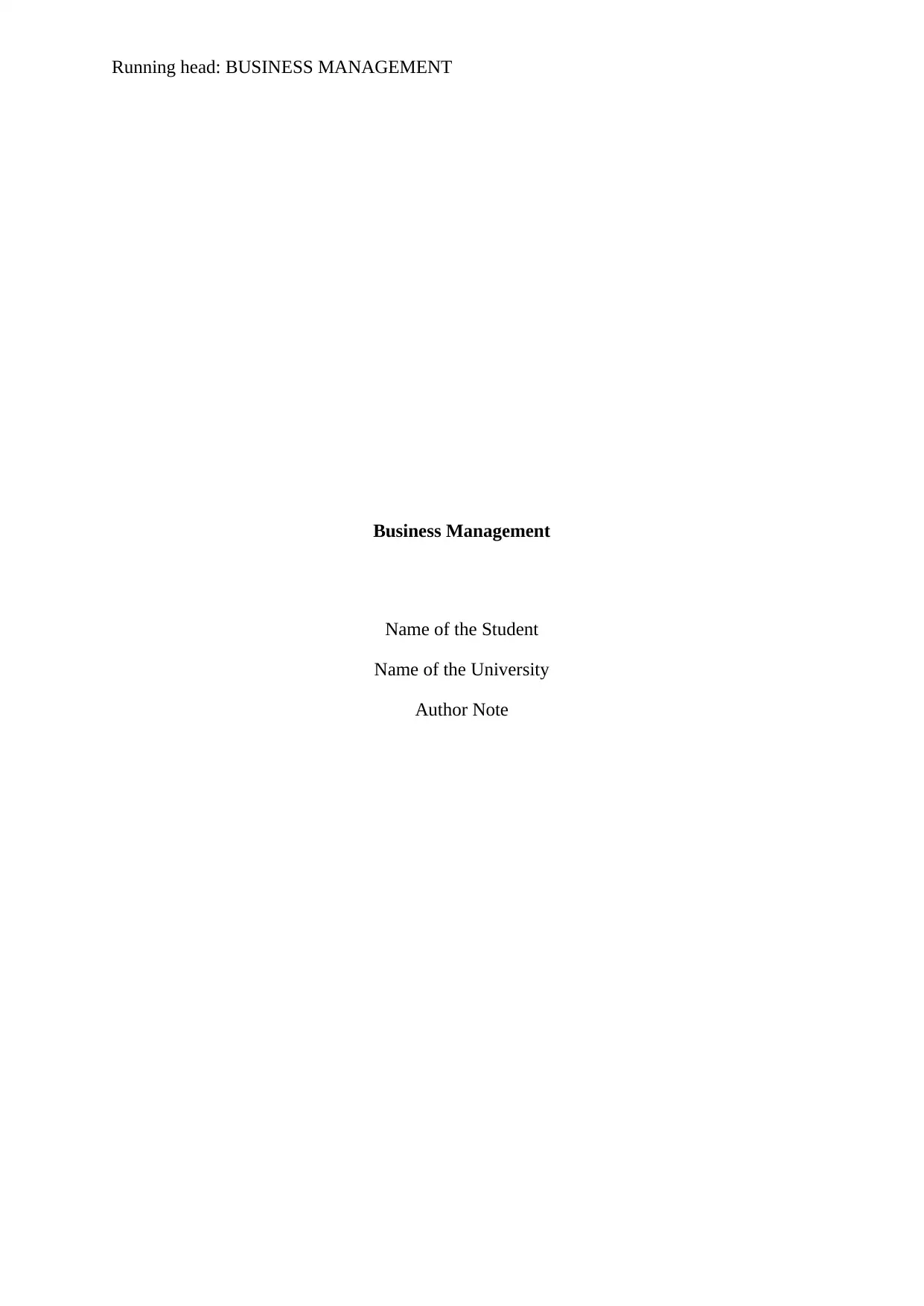
Running head: BUSINESS MANAGEMENT
Business Management
Name of the Student
Name of the University
Author Note
Business Management
Name of the Student
Name of the University
Author Note
Secure Best Marks with AI Grader
Need help grading? Try our AI Grader for instant feedback on your assignments.
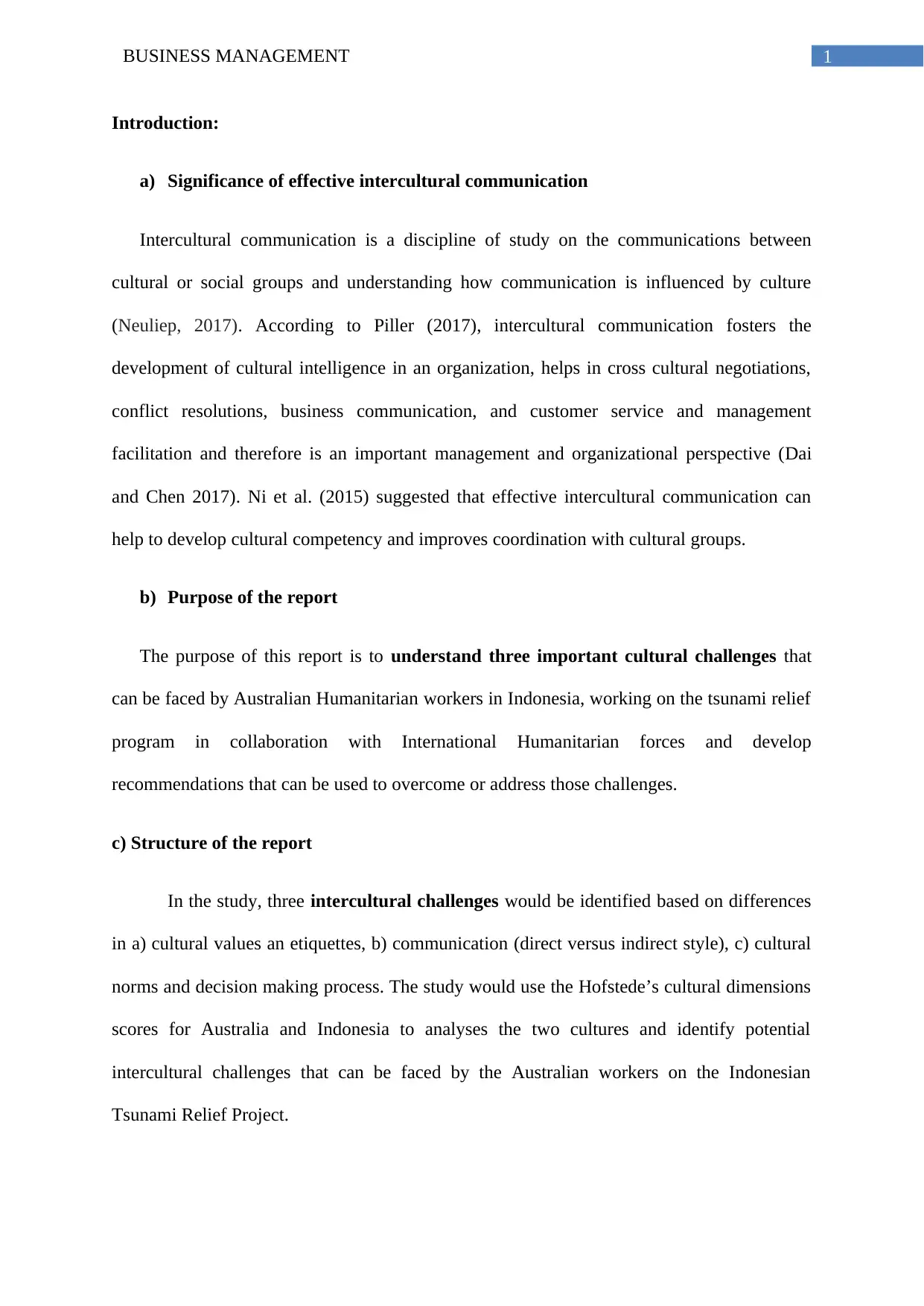
1BUSINESS MANAGEMENT
Introduction:
a) Significance of effective intercultural communication
Intercultural communication is a discipline of study on the communications between
cultural or social groups and understanding how communication is influenced by culture
(Neuliep, 2017). According to Piller (2017), intercultural communication fosters the
development of cultural intelligence in an organization, helps in cross cultural negotiations,
conflict resolutions, business communication, and customer service and management
facilitation and therefore is an important management and organizational perspective (Dai
and Chen 2017). Ni et al. (2015) suggested that effective intercultural communication can
help to develop cultural competency and improves coordination with cultural groups.
b) Purpose of the report
The purpose of this report is to understand three important cultural challenges that
can be faced by Australian Humanitarian workers in Indonesia, working on the tsunami relief
program in collaboration with International Humanitarian forces and develop
recommendations that can be used to overcome or address those challenges.
c) Structure of the report
In the study, three intercultural challenges would be identified based on differences
in a) cultural values an etiquettes, b) communication (direct versus indirect style), c) cultural
norms and decision making process. The study would use the Hofstede’s cultural dimensions
scores for Australia and Indonesia to analyses the two cultures and identify potential
intercultural challenges that can be faced by the Australian workers on the Indonesian
Tsunami Relief Project.
Introduction:
a) Significance of effective intercultural communication
Intercultural communication is a discipline of study on the communications between
cultural or social groups and understanding how communication is influenced by culture
(Neuliep, 2017). According to Piller (2017), intercultural communication fosters the
development of cultural intelligence in an organization, helps in cross cultural negotiations,
conflict resolutions, business communication, and customer service and management
facilitation and therefore is an important management and organizational perspective (Dai
and Chen 2017). Ni et al. (2015) suggested that effective intercultural communication can
help to develop cultural competency and improves coordination with cultural groups.
b) Purpose of the report
The purpose of this report is to understand three important cultural challenges that
can be faced by Australian Humanitarian workers in Indonesia, working on the tsunami relief
program in collaboration with International Humanitarian forces and develop
recommendations that can be used to overcome or address those challenges.
c) Structure of the report
In the study, three intercultural challenges would be identified based on differences
in a) cultural values an etiquettes, b) communication (direct versus indirect style), c) cultural
norms and decision making process. The study would use the Hofstede’s cultural dimensions
scores for Australia and Indonesia to analyses the two cultures and identify potential
intercultural challenges that can be faced by the Australian workers on the Indonesian
Tsunami Relief Project.
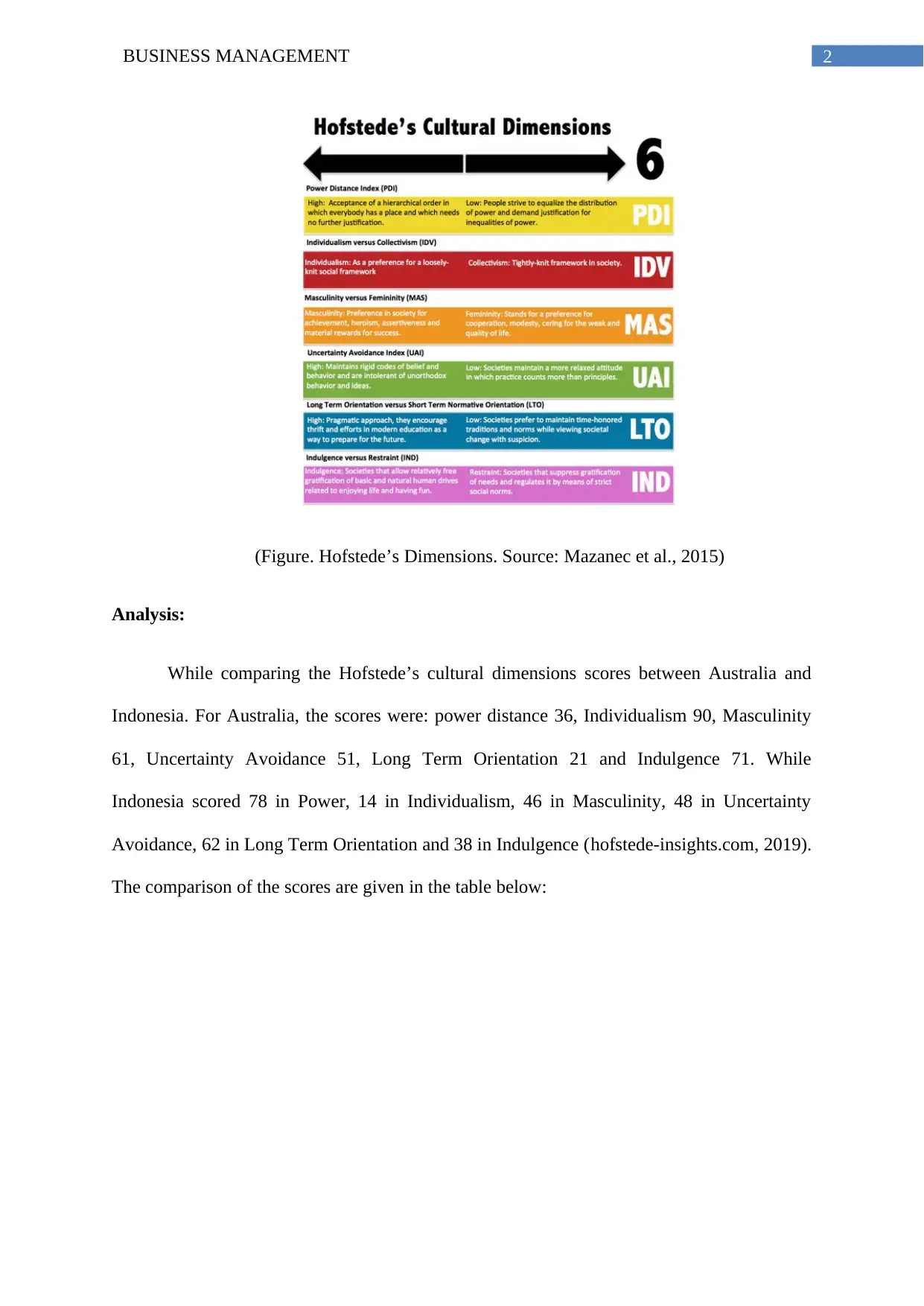
2BUSINESS MANAGEMENT
(Figure. Hofstede’s Dimensions. Source: Mazanec et al., 2015)
Analysis:
While comparing the Hofstede’s cultural dimensions scores between Australia and
Indonesia. For Australia, the scores were: power distance 36, Individualism 90, Masculinity
61, Uncertainty Avoidance 51, Long Term Orientation 21 and Indulgence 71. While
Indonesia scored 78 in Power, 14 in Individualism, 46 in Masculinity, 48 in Uncertainty
Avoidance, 62 in Long Term Orientation and 38 in Indulgence (hofstede-insights.com, 2019).
The comparison of the scores are given in the table below:
(Figure. Hofstede’s Dimensions. Source: Mazanec et al., 2015)
Analysis:
While comparing the Hofstede’s cultural dimensions scores between Australia and
Indonesia. For Australia, the scores were: power distance 36, Individualism 90, Masculinity
61, Uncertainty Avoidance 51, Long Term Orientation 21 and Indulgence 71. While
Indonesia scored 78 in Power, 14 in Individualism, 46 in Masculinity, 48 in Uncertainty
Avoidance, 62 in Long Term Orientation and 38 in Indulgence (hofstede-insights.com, 2019).
The comparison of the scores are given in the table below:
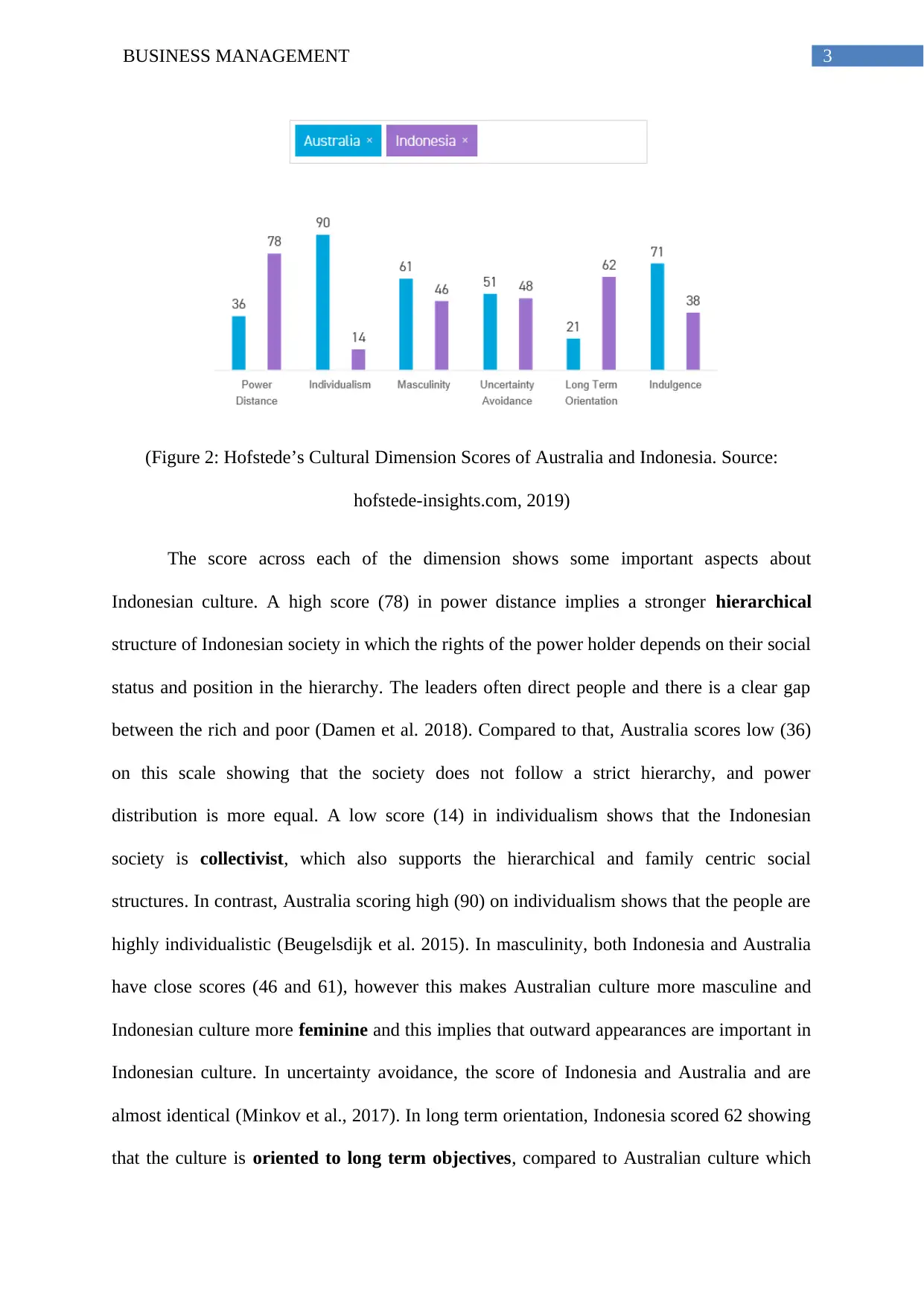
3BUSINESS MANAGEMENT
(Figure 2: Hofstede’s Cultural Dimension Scores of Australia and Indonesia. Source:
hofstede-insights.com, 2019)
The score across each of the dimension shows some important aspects about
Indonesian culture. A high score (78) in power distance implies a stronger hierarchical
structure of Indonesian society in which the rights of the power holder depends on their social
status and position in the hierarchy. The leaders often direct people and there is a clear gap
between the rich and poor (Damen et al. 2018). Compared to that, Australia scores low (36)
on this scale showing that the society does not follow a strict hierarchy, and power
distribution is more equal. A low score (14) in individualism shows that the Indonesian
society is collectivist, which also supports the hierarchical and family centric social
structures. In contrast, Australia scoring high (90) on individualism shows that the people are
highly individualistic (Beugelsdijk et al. 2015). In masculinity, both Indonesia and Australia
have close scores (46 and 61), however this makes Australian culture more masculine and
Indonesian culture more feminine and this implies that outward appearances are important in
Indonesian culture. In uncertainty avoidance, the score of Indonesia and Australia and are
almost identical (Minkov et al., 2017). In long term orientation, Indonesia scored 62 showing
that the culture is oriented to long term objectives, compared to Australian culture which
(Figure 2: Hofstede’s Cultural Dimension Scores of Australia and Indonesia. Source:
hofstede-insights.com, 2019)
The score across each of the dimension shows some important aspects about
Indonesian culture. A high score (78) in power distance implies a stronger hierarchical
structure of Indonesian society in which the rights of the power holder depends on their social
status and position in the hierarchy. The leaders often direct people and there is a clear gap
between the rich and poor (Damen et al. 2018). Compared to that, Australia scores low (36)
on this scale showing that the society does not follow a strict hierarchy, and power
distribution is more equal. A low score (14) in individualism shows that the Indonesian
society is collectivist, which also supports the hierarchical and family centric social
structures. In contrast, Australia scoring high (90) on individualism shows that the people are
highly individualistic (Beugelsdijk et al. 2015). In masculinity, both Indonesia and Australia
have close scores (46 and 61), however this makes Australian culture more masculine and
Indonesian culture more feminine and this implies that outward appearances are important in
Indonesian culture. In uncertainty avoidance, the score of Indonesia and Australia and are
almost identical (Minkov et al., 2017). In long term orientation, Indonesia scored 62 showing
that the culture is oriented to long term objectives, compared to Australian culture which
Secure Best Marks with AI Grader
Need help grading? Try our AI Grader for instant feedback on your assignments.
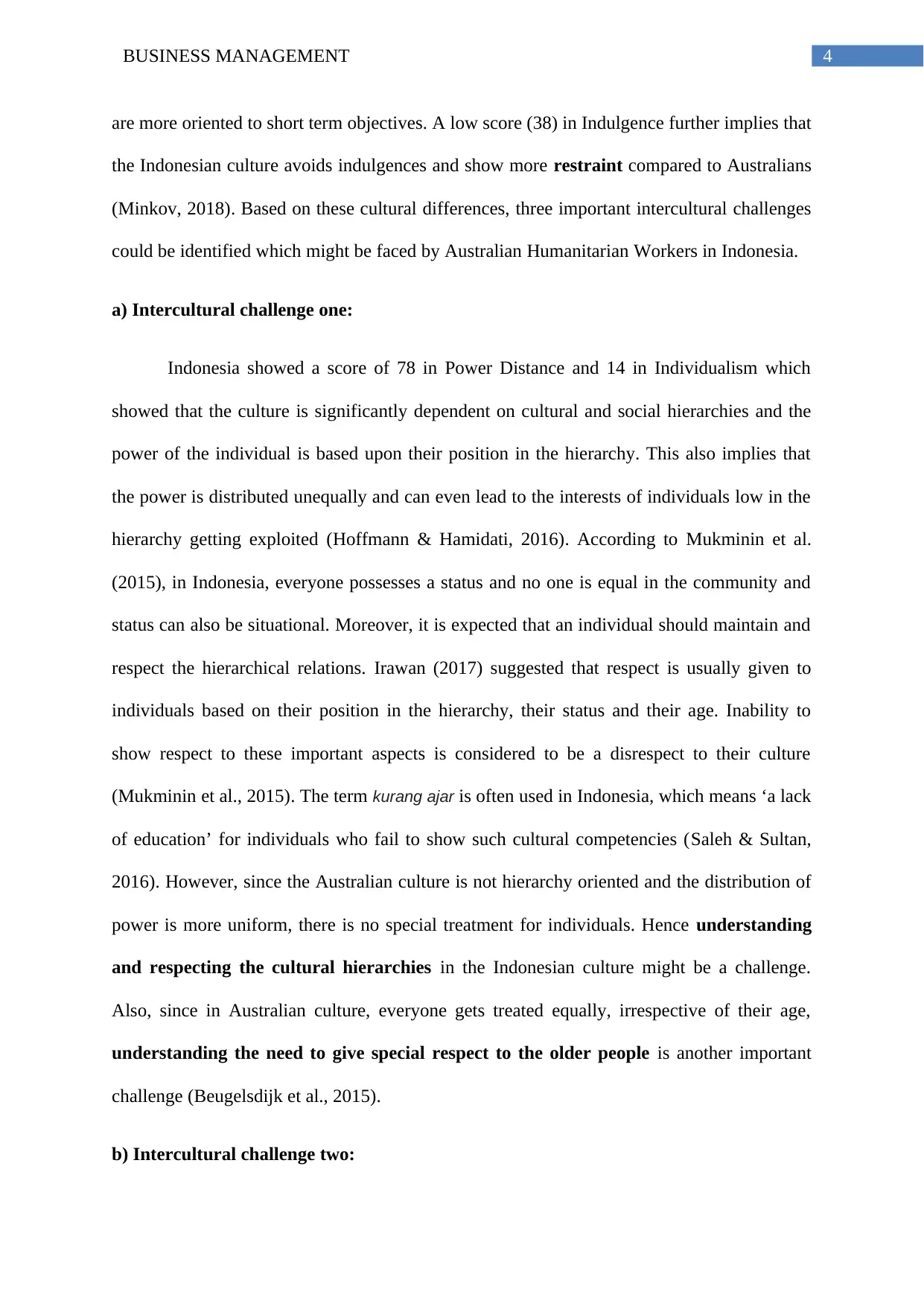
4BUSINESS MANAGEMENT
are more oriented to short term objectives. A low score (38) in Indulgence further implies that
the Indonesian culture avoids indulgences and show more restraint compared to Australians
(Minkov, 2018). Based on these cultural differences, three important intercultural challenges
could be identified which might be faced by Australian Humanitarian Workers in Indonesia.
a) Intercultural challenge one:
Indonesia showed a score of 78 in Power Distance and 14 in Individualism which
showed that the culture is significantly dependent on cultural and social hierarchies and the
power of the individual is based upon their position in the hierarchy. This also implies that
the power is distributed unequally and can even lead to the interests of individuals low in the
hierarchy getting exploited (Hoffmann & Hamidati, 2016). According to Mukminin et al.
(2015), in Indonesia, everyone possesses a status and no one is equal in the community and
status can also be situational. Moreover, it is expected that an individual should maintain and
respect the hierarchical relations. Irawan (2017) suggested that respect is usually given to
individuals based on their position in the hierarchy, their status and their age. Inability to
show respect to these important aspects is considered to be a disrespect to their culture
(Mukminin et al., 2015). The term kurang ajar is often used in Indonesia, which means ‘a lack
of education’ for individuals who fail to show such cultural competencies (Saleh & Sultan,
2016). However, since the Australian culture is not hierarchy oriented and the distribution of
power is more uniform, there is no special treatment for individuals. Hence understanding
and respecting the cultural hierarchies in the Indonesian culture might be a challenge.
Also, since in Australian culture, everyone gets treated equally, irrespective of their age,
understanding the need to give special respect to the older people is another important
challenge (Beugelsdijk et al., 2015).
b) Intercultural challenge two:
are more oriented to short term objectives. A low score (38) in Indulgence further implies that
the Indonesian culture avoids indulgences and show more restraint compared to Australians
(Minkov, 2018). Based on these cultural differences, three important intercultural challenges
could be identified which might be faced by Australian Humanitarian Workers in Indonesia.
a) Intercultural challenge one:
Indonesia showed a score of 78 in Power Distance and 14 in Individualism which
showed that the culture is significantly dependent on cultural and social hierarchies and the
power of the individual is based upon their position in the hierarchy. This also implies that
the power is distributed unequally and can even lead to the interests of individuals low in the
hierarchy getting exploited (Hoffmann & Hamidati, 2016). According to Mukminin et al.
(2015), in Indonesia, everyone possesses a status and no one is equal in the community and
status can also be situational. Moreover, it is expected that an individual should maintain and
respect the hierarchical relations. Irawan (2017) suggested that respect is usually given to
individuals based on their position in the hierarchy, their status and their age. Inability to
show respect to these important aspects is considered to be a disrespect to their culture
(Mukminin et al., 2015). The term kurang ajar is often used in Indonesia, which means ‘a lack
of education’ for individuals who fail to show such cultural competencies (Saleh & Sultan,
2016). However, since the Australian culture is not hierarchy oriented and the distribution of
power is more uniform, there is no special treatment for individuals. Hence understanding
and respecting the cultural hierarchies in the Indonesian culture might be a challenge.
Also, since in Australian culture, everyone gets treated equally, irrespective of their age,
understanding the need to give special respect to the older people is another important
challenge (Beugelsdijk et al., 2015).
b) Intercultural challenge two:
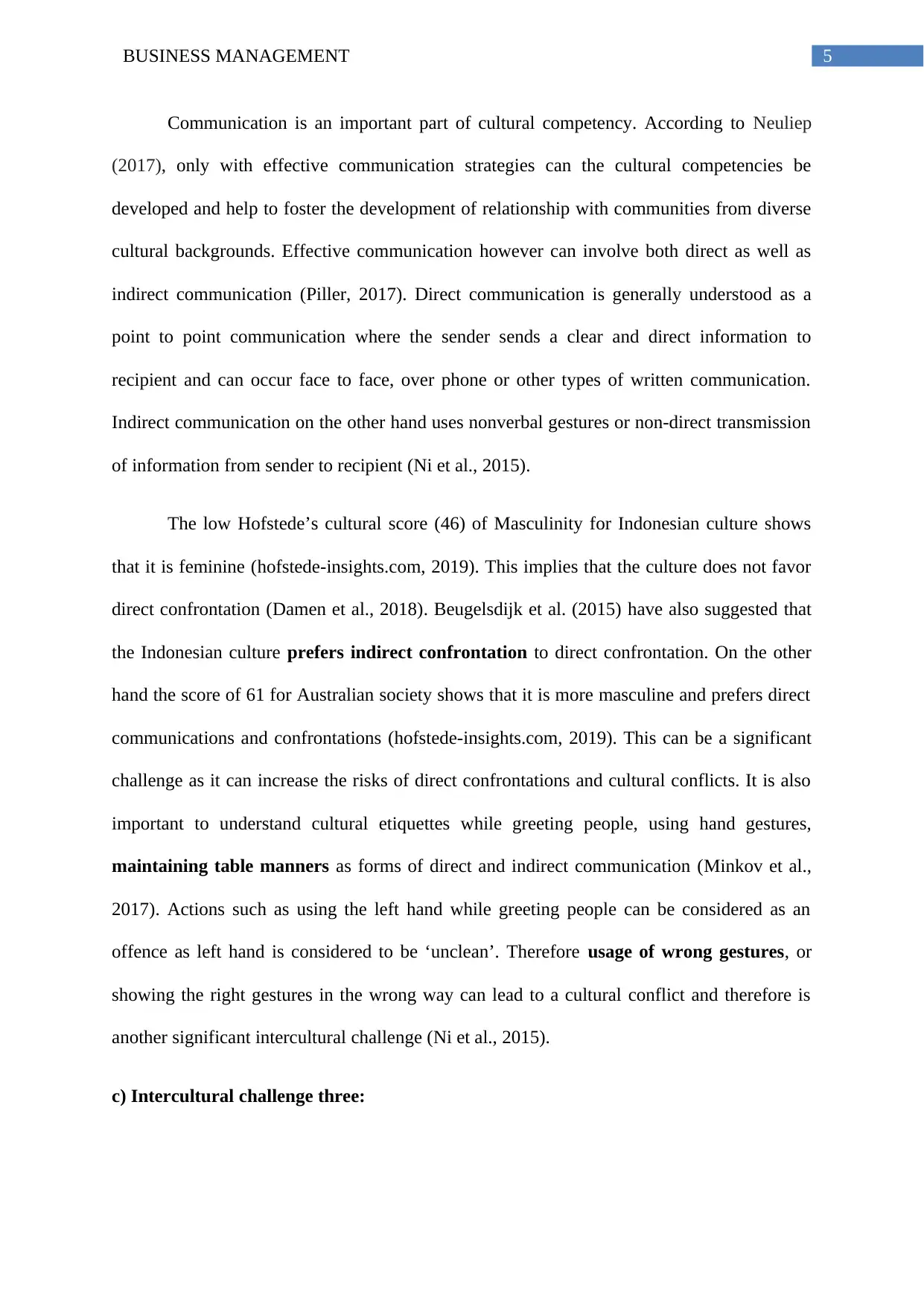
5BUSINESS MANAGEMENT
Communication is an important part of cultural competency. According to Neuliep
(2017), only with effective communication strategies can the cultural competencies be
developed and help to foster the development of relationship with communities from diverse
cultural backgrounds. Effective communication however can involve both direct as well as
indirect communication (Piller, 2017). Direct communication is generally understood as a
point to point communication where the sender sends a clear and direct information to
recipient and can occur face to face, over phone or other types of written communication.
Indirect communication on the other hand uses nonverbal gestures or non-direct transmission
of information from sender to recipient (Ni et al., 2015).
The low Hofstede’s cultural score (46) of Masculinity for Indonesian culture shows
that it is feminine (hofstede-insights.com, 2019). This implies that the culture does not favor
direct confrontation (Damen et al., 2018). Beugelsdijk et al. (2015) have also suggested that
the Indonesian culture prefers indirect confrontation to direct confrontation. On the other
hand the score of 61 for Australian society shows that it is more masculine and prefers direct
communications and confrontations (hofstede-insights.com, 2019). This can be a significant
challenge as it can increase the risks of direct confrontations and cultural conflicts. It is also
important to understand cultural etiquettes while greeting people, using hand gestures,
maintaining table manners as forms of direct and indirect communication (Minkov et al.,
2017). Actions such as using the left hand while greeting people can be considered as an
offence as left hand is considered to be ‘unclean’. Therefore usage of wrong gestures, or
showing the right gestures in the wrong way can lead to a cultural conflict and therefore is
another significant intercultural challenge (Ni et al., 2015).
c) Intercultural challenge three:
Communication is an important part of cultural competency. According to Neuliep
(2017), only with effective communication strategies can the cultural competencies be
developed and help to foster the development of relationship with communities from diverse
cultural backgrounds. Effective communication however can involve both direct as well as
indirect communication (Piller, 2017). Direct communication is generally understood as a
point to point communication where the sender sends a clear and direct information to
recipient and can occur face to face, over phone or other types of written communication.
Indirect communication on the other hand uses nonverbal gestures or non-direct transmission
of information from sender to recipient (Ni et al., 2015).
The low Hofstede’s cultural score (46) of Masculinity for Indonesian culture shows
that it is feminine (hofstede-insights.com, 2019). This implies that the culture does not favor
direct confrontation (Damen et al., 2018). Beugelsdijk et al. (2015) have also suggested that
the Indonesian culture prefers indirect confrontation to direct confrontation. On the other
hand the score of 61 for Australian society shows that it is more masculine and prefers direct
communications and confrontations (hofstede-insights.com, 2019). This can be a significant
challenge as it can increase the risks of direct confrontations and cultural conflicts. It is also
important to understand cultural etiquettes while greeting people, using hand gestures,
maintaining table manners as forms of direct and indirect communication (Minkov et al.,
2017). Actions such as using the left hand while greeting people can be considered as an
offence as left hand is considered to be ‘unclean’. Therefore usage of wrong gestures, or
showing the right gestures in the wrong way can lead to a cultural conflict and therefore is
another significant intercultural challenge (Ni et al., 2015).
c) Intercultural challenge three:
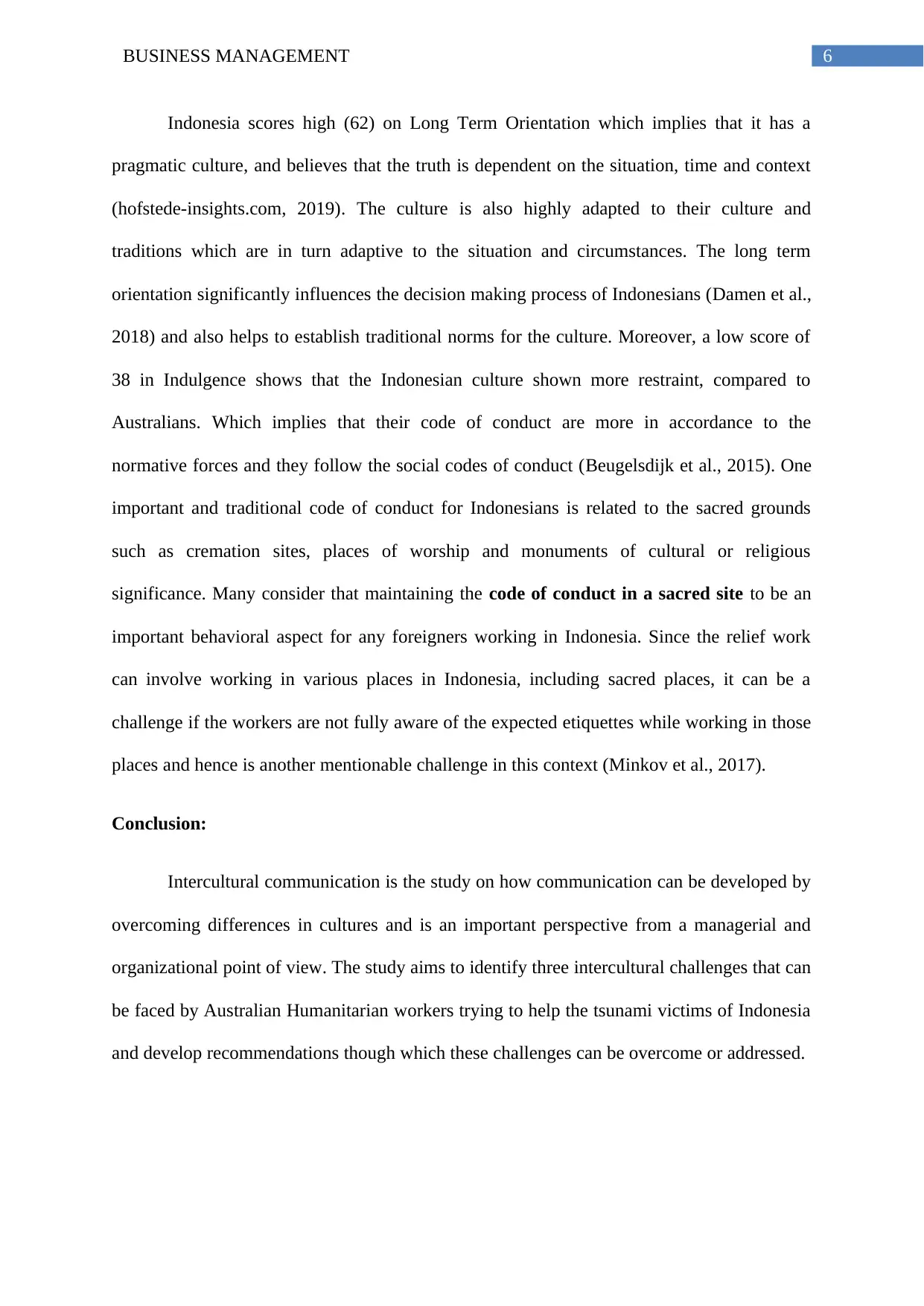
6BUSINESS MANAGEMENT
Indonesia scores high (62) on Long Term Orientation which implies that it has a
pragmatic culture, and believes that the truth is dependent on the situation, time and context
(hofstede-insights.com, 2019). The culture is also highly adapted to their culture and
traditions which are in turn adaptive to the situation and circumstances. The long term
orientation significantly influences the decision making process of Indonesians (Damen et al.,
2018) and also helps to establish traditional norms for the culture. Moreover, a low score of
38 in Indulgence shows that the Indonesian culture shown more restraint, compared to
Australians. Which implies that their code of conduct are more in accordance to the
normative forces and they follow the social codes of conduct (Beugelsdijk et al., 2015). One
important and traditional code of conduct for Indonesians is related to the sacred grounds
such as cremation sites, places of worship and monuments of cultural or religious
significance. Many consider that maintaining the code of conduct in a sacred site to be an
important behavioral aspect for any foreigners working in Indonesia. Since the relief work
can involve working in various places in Indonesia, including sacred places, it can be a
challenge if the workers are not fully aware of the expected etiquettes while working in those
places and hence is another mentionable challenge in this context (Minkov et al., 2017).
Conclusion:
Intercultural communication is the study on how communication can be developed by
overcoming differences in cultures and is an important perspective from a managerial and
organizational point of view. The study aims to identify three intercultural challenges that can
be faced by Australian Humanitarian workers trying to help the tsunami victims of Indonesia
and develop recommendations though which these challenges can be overcome or addressed.
Indonesia scores high (62) on Long Term Orientation which implies that it has a
pragmatic culture, and believes that the truth is dependent on the situation, time and context
(hofstede-insights.com, 2019). The culture is also highly adapted to their culture and
traditions which are in turn adaptive to the situation and circumstances. The long term
orientation significantly influences the decision making process of Indonesians (Damen et al.,
2018) and also helps to establish traditional norms for the culture. Moreover, a low score of
38 in Indulgence shows that the Indonesian culture shown more restraint, compared to
Australians. Which implies that their code of conduct are more in accordance to the
normative forces and they follow the social codes of conduct (Beugelsdijk et al., 2015). One
important and traditional code of conduct for Indonesians is related to the sacred grounds
such as cremation sites, places of worship and monuments of cultural or religious
significance. Many consider that maintaining the code of conduct in a sacred site to be an
important behavioral aspect for any foreigners working in Indonesia. Since the relief work
can involve working in various places in Indonesia, including sacred places, it can be a
challenge if the workers are not fully aware of the expected etiquettes while working in those
places and hence is another mentionable challenge in this context (Minkov et al., 2017).
Conclusion:
Intercultural communication is the study on how communication can be developed by
overcoming differences in cultures and is an important perspective from a managerial and
organizational point of view. The study aims to identify three intercultural challenges that can
be faced by Australian Humanitarian workers trying to help the tsunami victims of Indonesia
and develop recommendations though which these challenges can be overcome or addressed.
Paraphrase This Document
Need a fresh take? Get an instant paraphrase of this document with our AI Paraphraser
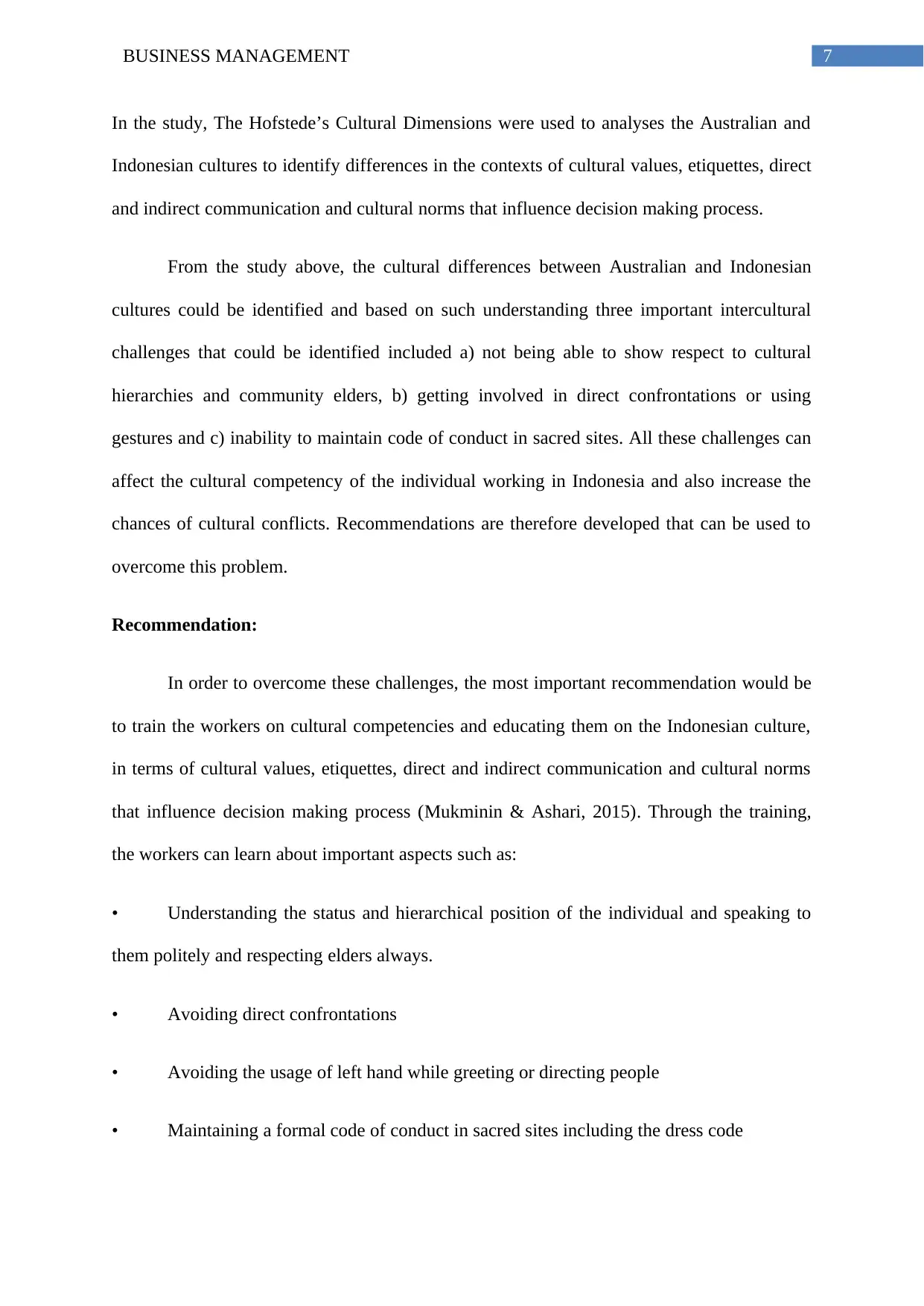
7BUSINESS MANAGEMENT
In the study, The Hofstede’s Cultural Dimensions were used to analyses the Australian and
Indonesian cultures to identify differences in the contexts of cultural values, etiquettes, direct
and indirect communication and cultural norms that influence decision making process.
From the study above, the cultural differences between Australian and Indonesian
cultures could be identified and based on such understanding three important intercultural
challenges that could be identified included a) not being able to show respect to cultural
hierarchies and community elders, b) getting involved in direct confrontations or using
gestures and c) inability to maintain code of conduct in sacred sites. All these challenges can
affect the cultural competency of the individual working in Indonesia and also increase the
chances of cultural conflicts. Recommendations are therefore developed that can be used to
overcome this problem.
Recommendation:
In order to overcome these challenges, the most important recommendation would be
to train the workers on cultural competencies and educating them on the Indonesian culture,
in terms of cultural values, etiquettes, direct and indirect communication and cultural norms
that influence decision making process (Mukminin & Ashari, 2015). Through the training,
the workers can learn about important aspects such as:
• Understanding the status and hierarchical position of the individual and speaking to
them politely and respecting elders always.
• Avoiding direct confrontations
• Avoiding the usage of left hand while greeting or directing people
• Maintaining a formal code of conduct in sacred sites including the dress code
In the study, The Hofstede’s Cultural Dimensions were used to analyses the Australian and
Indonesian cultures to identify differences in the contexts of cultural values, etiquettes, direct
and indirect communication and cultural norms that influence decision making process.
From the study above, the cultural differences between Australian and Indonesian
cultures could be identified and based on such understanding three important intercultural
challenges that could be identified included a) not being able to show respect to cultural
hierarchies and community elders, b) getting involved in direct confrontations or using
gestures and c) inability to maintain code of conduct in sacred sites. All these challenges can
affect the cultural competency of the individual working in Indonesia and also increase the
chances of cultural conflicts. Recommendations are therefore developed that can be used to
overcome this problem.
Recommendation:
In order to overcome these challenges, the most important recommendation would be
to train the workers on cultural competencies and educating them on the Indonesian culture,
in terms of cultural values, etiquettes, direct and indirect communication and cultural norms
that influence decision making process (Mukminin & Ashari, 2015). Through the training,
the workers can learn about important aspects such as:
• Understanding the status and hierarchical position of the individual and speaking to
them politely and respecting elders always.
• Avoiding direct confrontations
• Avoiding the usage of left hand while greeting or directing people
• Maintaining a formal code of conduct in sacred sites including the dress code
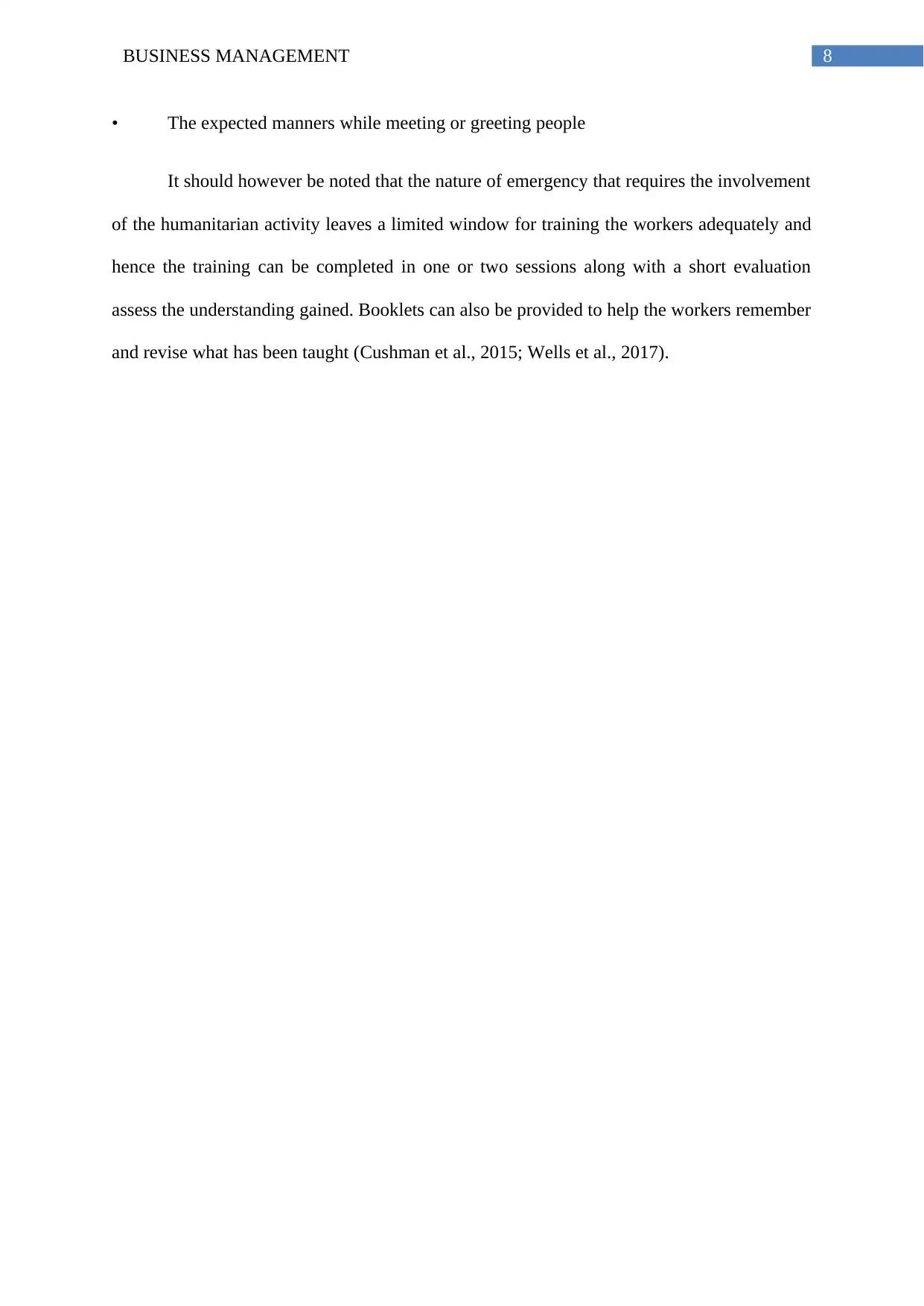
8BUSINESS MANAGEMENT
• The expected manners while meeting or greeting people
It should however be noted that the nature of emergency that requires the involvement
of the humanitarian activity leaves a limited window for training the workers adequately and
hence the training can be completed in one or two sessions along with a short evaluation
assess the understanding gained. Booklets can also be provided to help the workers remember
and revise what has been taught (Cushman et al., 2015; Wells et al., 2017).
• The expected manners while meeting or greeting people
It should however be noted that the nature of emergency that requires the involvement
of the humanitarian activity leaves a limited window for training the workers adequately and
hence the training can be completed in one or two sessions along with a short evaluation
assess the understanding gained. Booklets can also be provided to help the workers remember
and revise what has been taught (Cushman et al., 2015; Wells et al., 2017).
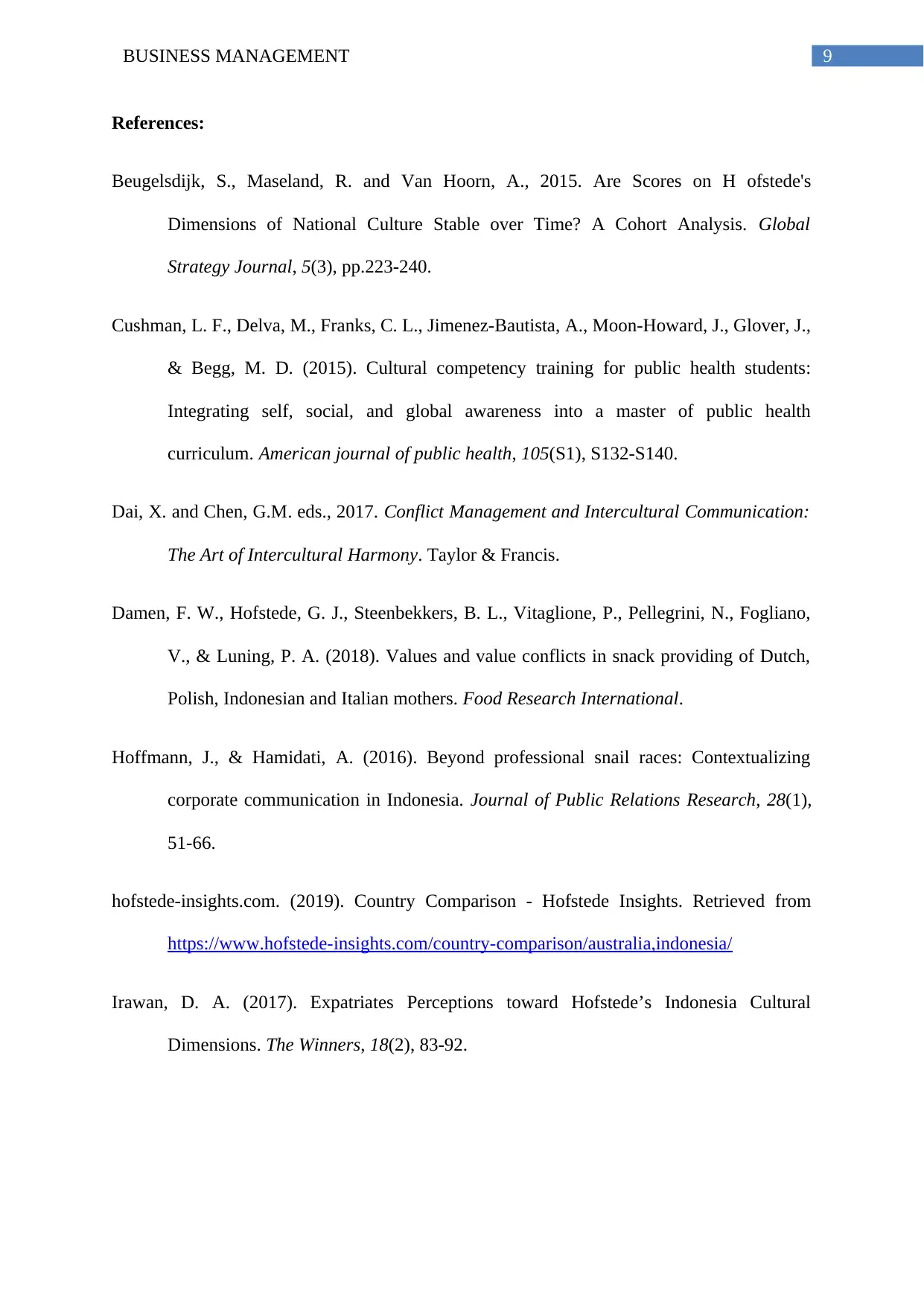
9BUSINESS MANAGEMENT
References:
Beugelsdijk, S., Maseland, R. and Van Hoorn, A., 2015. Are Scores on H ofstede's
Dimensions of National Culture Stable over Time? A Cohort Analysis. Global
Strategy Journal, 5(3), pp.223-240.
Cushman, L. F., Delva, M., Franks, C. L., Jimenez-Bautista, A., Moon-Howard, J., Glover, J.,
& Begg, M. D. (2015). Cultural competency training for public health students:
Integrating self, social, and global awareness into a master of public health
curriculum. American journal of public health, 105(S1), S132-S140.
Dai, X. and Chen, G.M. eds., 2017. Conflict Management and Intercultural Communication:
The Art of Intercultural Harmony. Taylor & Francis.
Damen, F. W., Hofstede, G. J., Steenbekkers, B. L., Vitaglione, P., Pellegrini, N., Fogliano,
V., & Luning, P. A. (2018). Values and value conflicts in snack providing of Dutch,
Polish, Indonesian and Italian mothers. Food Research International.
Hoffmann, J., & Hamidati, A. (2016). Beyond professional snail races: Contextualizing
corporate communication in Indonesia. Journal of Public Relations Research, 28(1),
51-66.
hofstede-insights.com. (2019). Country Comparison - Hofstede Insights. Retrieved from
https://www.hofstede-insights.com/country-comparison/australia,indonesia/
Irawan, D. A. (2017). Expatriates Perceptions toward Hofstede’s Indonesia Cultural
Dimensions. The Winners, 18(2), 83-92.
References:
Beugelsdijk, S., Maseland, R. and Van Hoorn, A., 2015. Are Scores on H ofstede's
Dimensions of National Culture Stable over Time? A Cohort Analysis. Global
Strategy Journal, 5(3), pp.223-240.
Cushman, L. F., Delva, M., Franks, C. L., Jimenez-Bautista, A., Moon-Howard, J., Glover, J.,
& Begg, M. D. (2015). Cultural competency training for public health students:
Integrating self, social, and global awareness into a master of public health
curriculum. American journal of public health, 105(S1), S132-S140.
Dai, X. and Chen, G.M. eds., 2017. Conflict Management and Intercultural Communication:
The Art of Intercultural Harmony. Taylor & Francis.
Damen, F. W., Hofstede, G. J., Steenbekkers, B. L., Vitaglione, P., Pellegrini, N., Fogliano,
V., & Luning, P. A. (2018). Values and value conflicts in snack providing of Dutch,
Polish, Indonesian and Italian mothers. Food Research International.
Hoffmann, J., & Hamidati, A. (2016). Beyond professional snail races: Contextualizing
corporate communication in Indonesia. Journal of Public Relations Research, 28(1),
51-66.
hofstede-insights.com. (2019). Country Comparison - Hofstede Insights. Retrieved from
https://www.hofstede-insights.com/country-comparison/australia,indonesia/
Irawan, D. A. (2017). Expatriates Perceptions toward Hofstede’s Indonesia Cultural
Dimensions. The Winners, 18(2), 83-92.
Secure Best Marks with AI Grader
Need help grading? Try our AI Grader for instant feedback on your assignments.
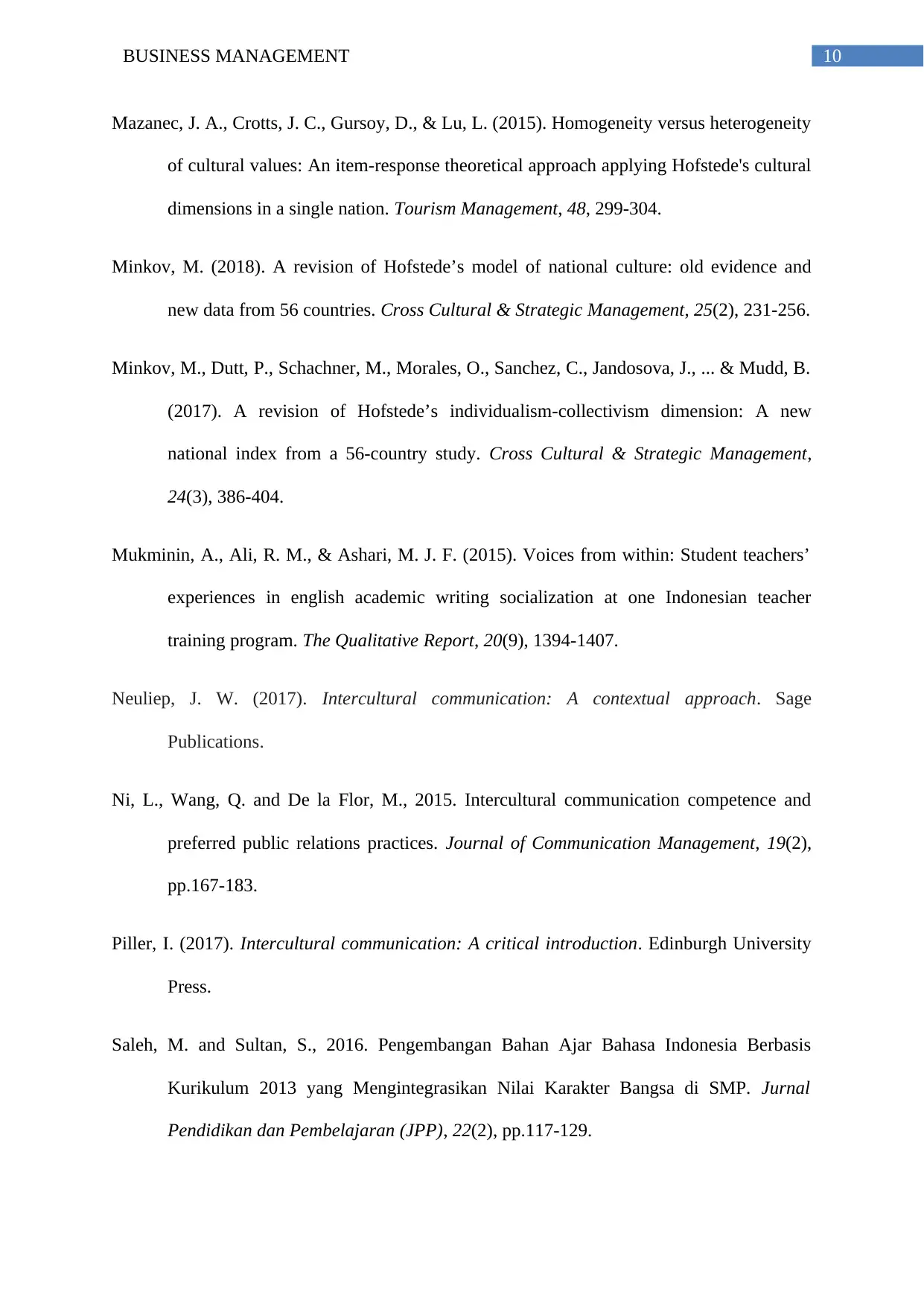
10BUSINESS MANAGEMENT
Mazanec, J. A., Crotts, J. C., Gursoy, D., & Lu, L. (2015). Homogeneity versus heterogeneity
of cultural values: An item-response theoretical approach applying Hofstede's cultural
dimensions in a single nation. Tourism Management, 48, 299-304.
Minkov, M. (2018). A revision of Hofstede’s model of national culture: old evidence and
new data from 56 countries. Cross Cultural & Strategic Management, 25(2), 231-256.
Minkov, M., Dutt, P., Schachner, M., Morales, O., Sanchez, C., Jandosova, J., ... & Mudd, B.
(2017). A revision of Hofstede’s individualism-collectivism dimension: A new
national index from a 56-country study. Cross Cultural & Strategic Management,
24(3), 386-404.
Mukminin, A., Ali, R. M., & Ashari, M. J. F. (2015). Voices from within: Student teachers’
experiences in english academic writing socialization at one Indonesian teacher
training program. The Qualitative Report, 20(9), 1394-1407.
Neuliep, J. W. (2017). Intercultural communication: A contextual approach. Sage
Publications.
Ni, L., Wang, Q. and De la Flor, M., 2015. Intercultural communication competence and
preferred public relations practices. Journal of Communication Management, 19(2),
pp.167-183.
Piller, I. (2017). Intercultural communication: A critical introduction. Edinburgh University
Press.
Saleh, M. and Sultan, S., 2016. Pengembangan Bahan Ajar Bahasa Indonesia Berbasis
Kurikulum 2013 yang Mengintegrasikan Nilai Karakter Bangsa di SMP. Jurnal
Pendidikan dan Pembelajaran (JPP), 22(2), pp.117-129.
Mazanec, J. A., Crotts, J. C., Gursoy, D., & Lu, L. (2015). Homogeneity versus heterogeneity
of cultural values: An item-response theoretical approach applying Hofstede's cultural
dimensions in a single nation. Tourism Management, 48, 299-304.
Minkov, M. (2018). A revision of Hofstede’s model of national culture: old evidence and
new data from 56 countries. Cross Cultural & Strategic Management, 25(2), 231-256.
Minkov, M., Dutt, P., Schachner, M., Morales, O., Sanchez, C., Jandosova, J., ... & Mudd, B.
(2017). A revision of Hofstede’s individualism-collectivism dimension: A new
national index from a 56-country study. Cross Cultural & Strategic Management,
24(3), 386-404.
Mukminin, A., Ali, R. M., & Ashari, M. J. F. (2015). Voices from within: Student teachers’
experiences in english academic writing socialization at one Indonesian teacher
training program. The Qualitative Report, 20(9), 1394-1407.
Neuliep, J. W. (2017). Intercultural communication: A contextual approach. Sage
Publications.
Ni, L., Wang, Q. and De la Flor, M., 2015. Intercultural communication competence and
preferred public relations practices. Journal of Communication Management, 19(2),
pp.167-183.
Piller, I. (2017). Intercultural communication: A critical introduction. Edinburgh University
Press.
Saleh, M. and Sultan, S., 2016. Pengembangan Bahan Ajar Bahasa Indonesia Berbasis
Kurikulum 2013 yang Mengintegrasikan Nilai Karakter Bangsa di SMP. Jurnal
Pendidikan dan Pembelajaran (JPP), 22(2), pp.117-129.
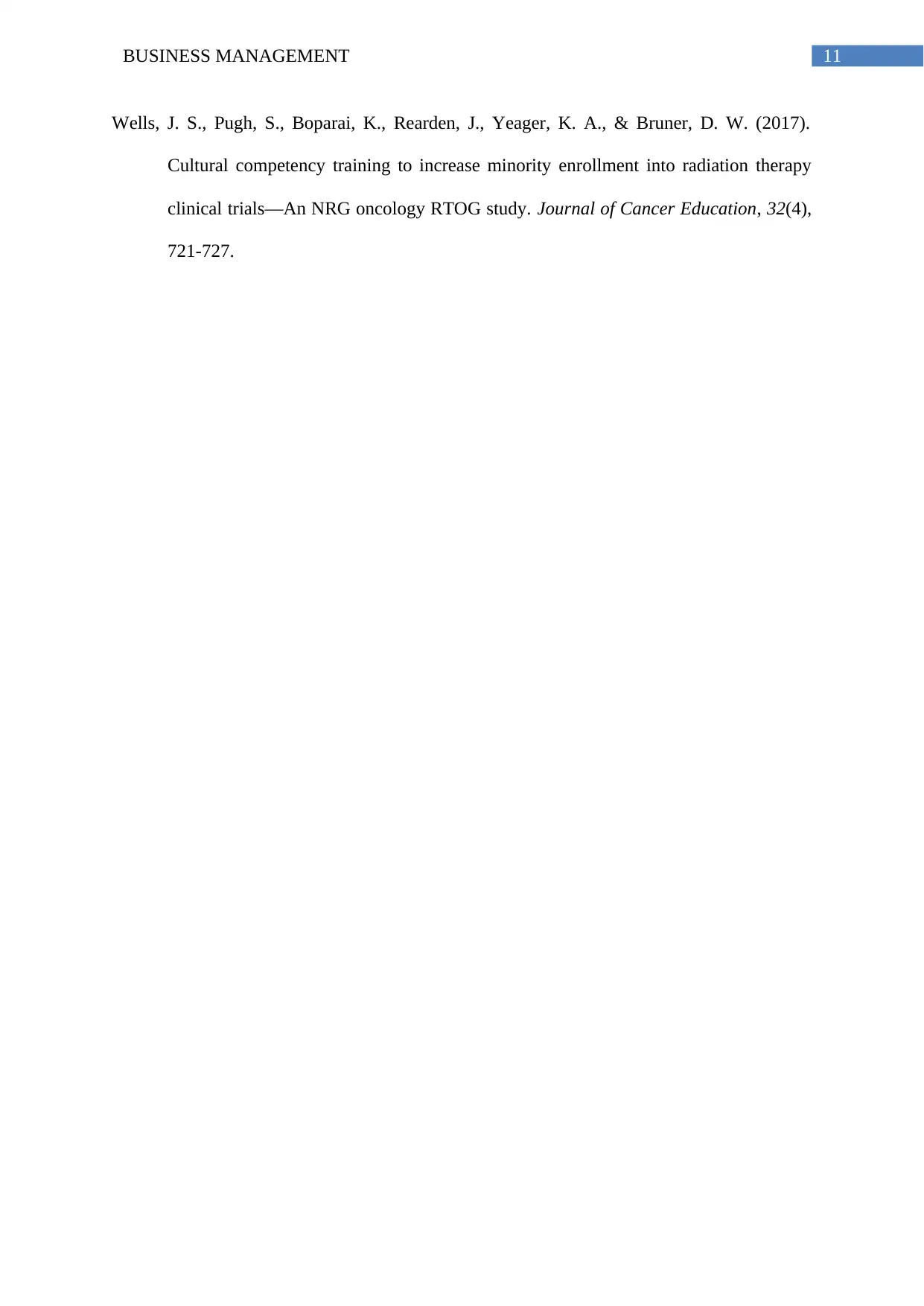
11BUSINESS MANAGEMENT
Wells, J. S., Pugh, S., Boparai, K., Rearden, J., Yeager, K. A., & Bruner, D. W. (2017).
Cultural competency training to increase minority enrollment into radiation therapy
clinical trials—An NRG oncology RTOG study. Journal of Cancer Education, 32(4),
721-727.
Wells, J. S., Pugh, S., Boparai, K., Rearden, J., Yeager, K. A., & Bruner, D. W. (2017).
Cultural competency training to increase minority enrollment into radiation therapy
clinical trials—An NRG oncology RTOG study. Journal of Cancer Education, 32(4),
721-727.
1 out of 12
Related Documents
Your All-in-One AI-Powered Toolkit for Academic Success.
+13062052269
info@desklib.com
Available 24*7 on WhatsApp / Email
![[object Object]](/_next/static/media/star-bottom.7253800d.svg)
Unlock your academic potential
© 2024 | Zucol Services PVT LTD | All rights reserved.





